Fort Orange (New Netherland)
Fort Orange (Dutch: Fort Oranje) was the first permanent Dutch settlement in New Netherland; the present-day city of Albany, New York developed at this site. It was built in 1624 as a replacement for Fort Nassau, which had been built on nearby Castle Island and served as a trading post until 1617 or 1618, when it was abandoned due to frequent flooding. Both forts were named in honor of the Dutch House of Orange-Nassau. Due to a dispute between the Director-General of New Netherland and the patroonship of Rensselaerswyck regarding jurisdiction over the fort and the surrounding community, the fort and community became an independent municipality, paving the way for the future city of Albany. After the English reconquered the region they soon abandoned Fort Orange (renamed Fort Albany) in favor of a new fort: Fort Frederick, constructed in 1676.
Excerpt from the Wikipedia article Fort Orange (New Netherland) (License: CC BY-SA 3.0, Authors).Fort Orange (New Netherland)
Broadway, City of Albany
Geographical coordinates (GPS) Address Nearby Places Show on map
Geographical coordinates (GPS)
| Latitude | Longitude |
|---|---|
| N 42.64485 ° | E -73.750291666667 ° |
Address
Broadway 298
12207 City of Albany
New York, United States
Open on Google Maps







